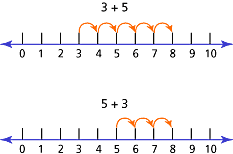
A number fact is made up of three numbers. These three numbers can be used to make up other number facts. Knowing one fact can help children with other facts. Look at the number facts we can make with the numbers 3, 4, and 7.
| Addition Facts | Subtraction Facts | Addition and subtraction are inverse operations because one operation can "undo" the other operation. Adding 3 and 5 to get 8 is the opposite of 8 minus 5, leaving 3.
|
||||||||||||||||||||||||||||||||||||
You can strengthen addition skills by investigating two special properties. Students may be familiar with the Order Property. It is also called theCommutative Property of Addition because it allows the order of the addends to be changed without affecting the sum. So, 3 + 5 has the same sum as 5 + 3.

Generally, subtraction facts are harder for children to learn than addition facts. If a child knows that
Begin your instruction by reviewing with children the related addition facts. Write
Then tell children that they are going to learn something new called a fact family. Explain that it is not a real family, but that the facts are related like people are related, therefore they have been given the name family.
Point to the two addition facts that you wrote on the board and say, "Now I am going to write two related facts." Write
Take time to discuss other fact families with children. Then write
Ask children why they think that it is important to learn fact families. Elicit that once they know one fact, that fact can help them find out the rest of the facts in the family. Tell children that they are now going to learn a lot more fact families.